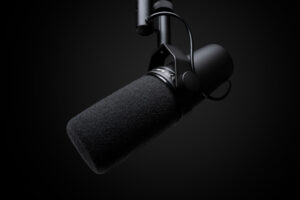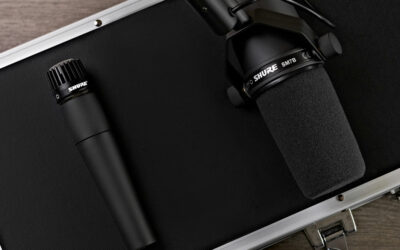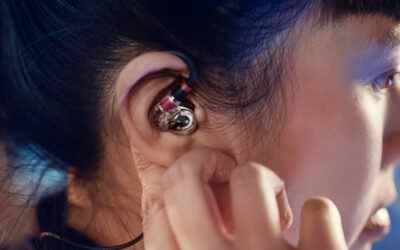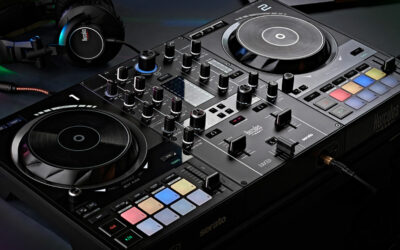If you’ve ever watched your favourite artist perform in a “Live Lounge” setting or spend a lot of time watching streamers and gamers on Twitch, then you’ve definitely seen the SM7B being used. It’s arguably one of the most iconic microphones ever made.
In 2023, the SM7B, released initially with the SM7, will celebrate its 50th anniversary. And unsurprisingly, it has a vast and interesting history that’s worth telling.
Before the SM7, there was a range of microphones that Shure created which would change the way we capture audio forever. This technology was called “Unidyne”.
Unidyne microphones started with the introduction of the Model 55, the first single-element microphone in the world. The Model 55, was much smaller and cheaper than other mics at the time, meaning it suited vocalists and public speakers all over the world.
As time went on, Unidyne technology was updated, and Unidyne II and Unidyne III microphones were made.
The SM7 we know today still uses the Unidyne III technology that was developed in the 1950s. Unidyne III microphones became “end-address” microphones rather than “side-address”, meaning you would talk into the end of the capsule, as you would on an SM58.
With Unidyne III, microphones could be much louder at live concerts, and their gain could be cranked higher before any feedback occurred. This was perfect for bands, and these mics quickly became popular with rock and blues musicians.
You can learn all about Shure’s history and how Unidyne revolutionised the music industry in our Unidyne blog post.
The birth of the SM7
 Before we get to the mic that inspired the SM7, the SM5, and the SM7 itself, let’s discuss how microphone technology developed.
Before we get to the mic that inspired the SM7, the SM5, and the SM7 itself, let’s discuss how microphone technology developed.
It all started with the Model 55 microphone, which was smaller, less expensive, and more accessible than other microphones in 1939. Over time, this technology developed, resulting in the Unidyne III capsule that the iconic SM58, SM57, and SM7B now use.
Shure engineer Bob Carr aimed to develop a range of microphones for TV, film, and radio. When he succeeded, it became known as the SM (Studio Microphones) series.
One model of the series was the SM5, which was designed as a boom microphone.
Other boom mics at the time were mainly condenser mics, whereas the SM5 was a dynamic microphone. This meant it struggled to keep up with its competitors due to having a much lower output.
The SM5 did, however, find a home in the radio industry as it was perfect for close-mic “broadcast” vocals, but it was very large and bulky. Plus, it was relatively expensive for the time – $225 in 1964 which is $1,860 in 2022.
In 1988, the SM5 was discontinued. Shure planned to redesign it to reduce cost and target the voice-over and broadcast industry.
Taking the technology from the SM5 and SM57, a popular mic of the SM series, Shure created the mic we now know as the SM7.
It was released in 1973 and saw only two updates, the first being the SM7A in 1999. This boasted an upgraded humbucking coil that reduced the sound of buzz and hub when the mic was near computers, as well as a redesigned yoke stand.
The second update was in 2001. A large windscreen was added as an accessory within the box to help remove plosives, meaning it sounded and looked more like the SM5. This was the SM7B.
The early days
 The SM7B was designed for voiceover and broadcast industries. However, it managed to find its way onto Michael Jackson’s Thriller, recording all of Michael’s vocals. Audio engineer for the album Bruce Swedien said that the SM7 was one of his favourite microphones.
The SM7B was designed for voiceover and broadcast industries. However, it managed to find its way onto Michael Jackson’s Thriller, recording all of Michael’s vocals. Audio engineer for the album Bruce Swedien said that the SM7 was one of his favourite microphones.
In addition to capturing the vocals of Michael Jackson, The Rolling Stones have also been known to use an SM7 and a Numan U87 for Mick Jagger’s vocals.
Between the years 1973 and 2008, the SM7B was already well-known, but it then became even more popular among podcasters in 2009.
Once people started to get more involved with online content creation such as streaming and gaming, the SM7B moved beyond radio and studio uses. The SM7B has now become one of the most iconic and popular microphones to use on vocals.
The SM7B today
Today we see the SM7B being used in a wide range of settings, such as studio recording, live music, podcasts, gaming, streaming, and voice-over work. Even after almost 50 years, it has been a go-to tool for capturing crisp and clear vocals.
In 2020, Shure released the MV7, this was the SM7B’s “little brother”. With the addition of a USB output, XLR output, headphone output, and onboard controls that can be managed via the Motiv App, the SM7B inspired the MV7.
Even though the mics look the same and can be used for similar things, the MV7 is not a replacement for the SM7B. The SM7B is still the microphone you wish you had in your microphone toolbox, because of its amazing sound quality.
Shure’s MV7 offers similar versatility but at a lower price-point and with the idea of “plug and play”. It allows anyone to start recording with as little equipment as possible, no matter where they are. All you need is a phone or laptop, and you’re ready to start recording. After just two years, the MV7 is used by a range of content creators for podcasts, streaming, gaming, and music recording.
Experience it for yourself
 There’s a reason the SM7B is such a legendary microphone.
There’s a reason the SM7B is such a legendary microphone.
The only way for you to get a feel for it is to try one out on your next music project, stream, or podcast and see how effortless it is to get professional-sounding vocals instantly.
If you’ve always thought about getting into any of those pursuits, start off with the MV7 and then gradually work your way to the SM7B.
The MV7 is designed to help people grow into their sound and eventually upgrade to the iconic SM7B.





0 Comments